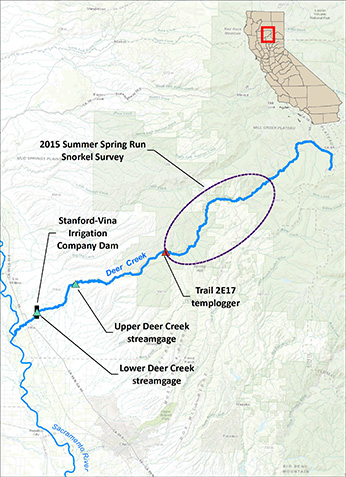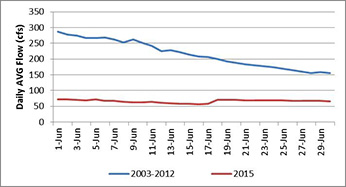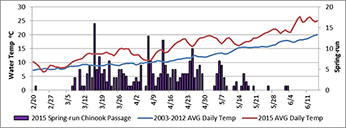(Deer Creek, Tehama County)
Species / Location
 Figure 1. Adult spring-run Chinook holding pool in upper Deer Creek
Figure 1. Adult spring-run Chinook holding pool in upper Deer Creek
 Figure 2. Map of Deer Creek and location of drought stressor monitoring locations.
Figure 2. Map of Deer Creek and location of drought stressor monitoring locations.
Deer Creek (Tehama County) is of one only three Central Valley streams still supporting an independent, wild population of State and Federally listed Central Valley spring-run Chinook salmon (Oncorhynchus tshawytscha) (spring-run) (Figures 1 and 2). Deer Creek is regarded as a high priority stream by the California Department of Fish and Wildlife (CDFW) due to its exceptional resource value, and is considered a conservation stronghold for the Central Valley spring-run Evolutionary Significant Unit by the National Marine Fisheries Service (NMFS) (NMFS 2014). Adult spring-run enter Deer Creek between late February and early July. They must quickly pass through the lower 20 miles of the creek to reach cold holding pools upstream where they rest and mature over summer (Figure 2). Spawning occurs late September to mid-October. After emerging from the gravel, a portion of Deer Creek juvenile spring-run begin the long migration to the ocean as tiny, one inch fry the first spring of their birth, while others remain in Deer Creek for up to a year before migrating as a much larger smolt.
Need for Drought Stressor Monitoring
During dry years agricultural water rights exceed total available unimpaired stream flow in Deer Creek. This puts agricultural practices at odds with spring-run during drought conditions, especially for late-migrating adult and juvenile spring-run. Two large agricultural diversion points decrease available water in the lowest 10 miles of Deer Creek, making it difficult for adult spring-run to swim past critical riffles and diversion structures. In addition, agricultural diversions contribute to increased water temperatures, resulting in thermal stress for adult and juvenile spring-run, increased predation on juvenile spring-run, and in some cases mortality. Careful monitoring of pre and post diversion stream flow and water temperature in Deer Creek is critical for managing limited available water for spring-run and agriculture during the drought.
Stressor Monitoring Efforts
In 2014 and 2015, CDFW and NMFS reached out to local water users in an effort to maintain agricultural water use while protecting the life history diversity of this unique population of spring-run during the drought. A California Endangered Species Act Memorandum of Understanding (CESA MOU) and NMFS Voluntary Drought Agreement were crafted to provide minimum protective flows in Deer Creek for spring-run. These agreements provided agricultural water users with incidental take coverage in the event spring-run were inadvertently harmed. Emergency flow regulations adopted by the California State Water Resources Control Board (SWRCB) provided a regulatory mechanism to protect spring-run in the absence of local cooperative agreements.
 Figure 3. Plot of average daily unimpaired Deer Creek stream flow in June for years 2003-2012 vs 2015.
Figure 3. Plot of average daily unimpaired Deer Creek stream flow in June for years 2003-2012 vs 2015.
 Figure 4. Plot of average daily Deer Creek water temperature 2003-2012 vs average daily water temperature in 2015, along with daily spring-run passage for the period February 20, 2015 through June 15, 2015.
Figure 4. Plot of average daily Deer Creek water temperature 2003-2012 vs average daily water temperature in 2015, along with daily spring-run passage for the period February 20, 2015 through June 15, 2015.
Unfortunately, not enough Deer Creek water-rights holders entered into voluntary agreements in 2014 and 2015, and the SWRCB had to curtail all Deer Creek water users to provide necessary minimum flow protection. Figure 3 illustrates how little water was available for spring-run and agriculture in Deer Creek in 2015, where average daily unimpaired June flow (2003-2012) is plotted against average daily June flow. Low flows, severely reduced snowpack, and above average temperatures resulted in increased water temperatures for Deer Creek’s adult spring run during the drought. Figure 4 plots average daily water temperatures 2003-2012 vs average daily water temperature in 2015 along with daily spring-run passage for the period February 20, 2015 through June 15, 2015.
As a result of drought, water temperatures in lower Deer Creek in 2015 were not optimal for adult and juvenile spring-run. However, wild salmon are very adaptable, and Chinook salmon from California’s Central Valley in particular have evolved the life-history resiliency necessary to cope with California’s variable water year types. Data used in Figures 3 and 4 were obtained from the upper, pre-diversion Deer Creek stream gage available online from the California Data Exchange website (Figure 5).
In addition to real-time flow and temperature monitoring in the agriculturally diverted sections of lower Deer Creek, the CDFW conducted enhanced adult spring-run monitoring in 2015. A video station located at Stanford-Vina Irrigation Company Dam (river mile 5) was used to obtain an estimated total of adult spring-run entering Deer Creek in 2015 (Figure 2). In addition, the video station provided nearly real-time adult spring-run passage data used to inform minimum flow requirements. A snorkel survey completed August 13, 2015 assessed the number of adult spring-run surviving the long drought summer in 2015 (Figure 6). This survey began at Upper Falls (upper limit of anadromy in Deer Creek) and ended approximately 3 miles below the Ponderosa Bridge crossing outside of Cohasset (Figure 2).
 Figure 5. Photo of the Upper Deer Creek Streamgage
Figure 5. Photo of the Upper Deer Creek Streamgage
 Figure 6. CDFW snorkel survey crew member entering the pool below Deer Creek’s Lower Falls August 13, 2015. CDFW Photo .
Figure 6. CDFW snorkel survey crew member entering the pool below Deer Creek’s Lower Falls August 13, 2015. CDFW Photo .
Findings
Minimum instream flow regulations provided passage for an estimated 268 Deer Creek spring-run in 2015. This was an extremely low population compared to historical numbers. However, the numbers in 2015 would have been much lower without outreach by the CDFW and NMFS and emergency flow protection by the SWRCB. Unfortunately, only 99 spring-run were observed on the August 13, 2015 snorkel survey. This snorkel count suggests that a high proportion of Deer Creek spring-run did not reach cold-water summer holding pools in the upper watershed, likely due to extremely low and warm water conditions resulting from the drought. Enhanced water temperature monitoring conducted by the CDFW in 2015 showed that the lower third of Deer Creek’s spring-run holding and spawning habitat had been adversely affected by a fourth year of drought (Figure 2). In fact, the Trail 2E17 water temperature logger showed water temperature readings reaching a lethal 25.7 oC in early July 2015 (Figure 2). It is doubtful that any spring-run holding below 2E17 could have survived the summer.
Future Efforts
Deer Creek spring-run returns were low compared to historical averages, and survival of the run over the summer was very poor in 2015, likely due to cumulative drought effects beginning in 2012. Ongoing enhanced monitoring of Deer Creek stream flow and water temperature is critical to ensuring that the population is allowed to recover. Continued real-time monitoring of Deer Creek’s adult spring-run population will determine run-timing patterns, and response to stream flow and water temperatures. This information, along with continued minimum flow protections provided by SWRCB emergency regulation and CESA MOU and NMFS Voluntary Drought Agreement participation will be necessary to protect Deer Creek’s spring-run during the next California drought.
References
- Recovery Plan for the Evolutionary Significant Units of Sacramento River Winter-Run Chinook Salmon and Central Valley Spring-Run Chinook Salmon and the Distinct Population Segment of California Central Valley Steelhead. National Marine Fisheries Service West Coast Region 2014.
CDFW
NOAA Fisheries